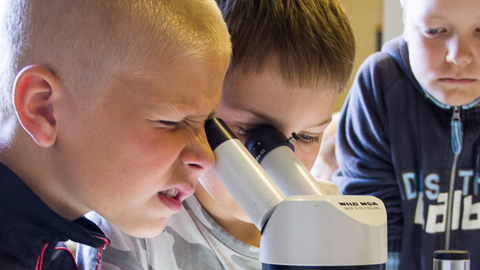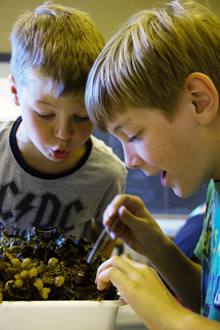The Sea and Past Centuries Were Explored on the Children’s University Camps
The Children’s University of the University of Turku organised five science camps last summer. On campus, children got to code their own games and explore astronomy, physics and robotics. At Vanhalinna in Lieto, the subject was nature and local history, and, at Seili Island, the children had a chance to take a trip to the sea and study insects.

Collaboration is the key. Eeli Heikkilä and Rudolf Laine are inspecting insects with a microscope. Veikka Lundelin is waiting his turn in the background.
–On the Baltic Sea excursion, we got to seine and gathered algae samples. We studied pearlfish and white-tipped mud crab. Now I also know what the compound eye of a gammarid shrimp looks like. It looks quite different with a microscope than with a naked eye, describes Emmi Suomela on the last day of the Seili camp.
 To many, the highlight of the Seili camp was when Sebastian Virtanen and Tiitus Ahlgren (photo on the right) found a white-tipped mud crab in their algae sample.
To many, the highlight of the Seili camp was when Sebastian Virtanen and Tiitus Ahlgren (photo on the right) found a white-tipped mud crab in their algae sample.
–Finding the crab was the best thing about the camp! It was dark brown and had a carapace. However, I did not feel like hugging it, laughs Sebastian.
On the science camps, the children get to experiment instead of just reading about science. The camps are for children from age ten to twelve. The exception is the game coding camp which was organized for the first time in the summer 2013. The camp was held at the Department of Information Technology and was aimed at 13–15 year-olds.
During the week-long camp, the children designed and coded their own game.
Many of the campers had very clear plans for their future. The most popular profession was a game tester.
–First, I wanted to make a game with several levels and with bats and flesh-eating plants in it. Now I understand that a week is too short a time. However, I’m already planning a new game. It could be the next big hit, muses Ville Nurmela on the second day of the camp.
It is important that, when planning the camp’s programme, the children’s capabilities and interests are taken into consideration. Each camp is also different depending on the samples and the participants’ interests.
–It is the greatest thing to witness when a child becomes truly inspired about something. For example, the campers come and ask where they can buy a microscope which they can take home, says teacher Ulla Anttila, who has run the Seili camp for six summers.
–In addition to explorations, we have also gone swimming and had fun. This week we have played, among other thing, freeze tag and capture the flag, laughs Anttila as she looks back on the camp’s activities.
Twin girls Viivi and Tiia Aaltonen are on the Seili camp for a third time.
–I think I want to study medicine at the University of Turku. Then, compared with the camp, I will have to study more and have less fun. Still, it is a long way away, says Tiia, when asked about what she wants to do when she grows up.
The atmosphere of the camp is hard to capture with photographs. However, Emmi Suomela boils it down well on day three of the Seili camp.
–I already called my mom and asked if I can come again next year.

On the Seili camp, Emmi Suomela (left) and Viivi Aaltonen, who is on the camp for a third time, are lying on the grass.

Rudolf Laine is trying to catch a butterfly at Seili.

With a microscope, you can find all kinds of small organisms from algae samples. Pinja Sjöroos is picking up an algae-covered stone from the sea at Seili.

The boys found a treasure from the beach. On the left Eeli Heikkilä, in the middle Tiitus Ahlgren and on the right Nuutti Isoniemi.
>> Photos from the 2013 Children’s University camps
Text: Eeva-Maria Soikkanen
Translation: Mari Ratia
Photographs: Hanna Oksanen